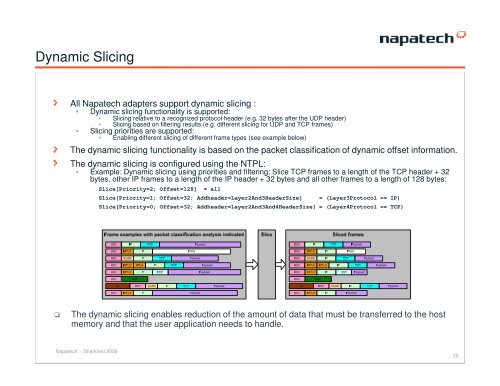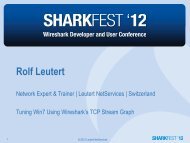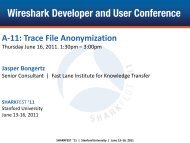Wireshark in a Multi-Core Environment Using Hardware Acceleration
Wireshark in a Multi-Core Environment Using Hardware Acceleration
Wireshark in a Multi-Core Environment Using Hardware Acceleration
Create successful ePaper yourself
Turn your PDF publications into a flip-book with our unique Google optimized e-Paper software.
Dynamic Slic<strong>in</strong>gAll Napatech adapters support dynamic slic<strong>in</strong>g :• Dynamic slic<strong>in</strong>g functionality is supported:• Slic<strong>in</strong>g relative to a recognized protocol header (e.g. 32 bytes after the UDP header)• Slic<strong>in</strong>g based on filter<strong>in</strong>g results (e.g. different slic<strong>in</strong>g for UDP and TCP frames)• Slic<strong>in</strong>g priorities are supported:• Enabl<strong>in</strong>g different slic<strong>in</strong>g of different frame types (see example below)The dynamic slic<strong>in</strong>g functionality is based on the packet classification of dynamic offset <strong>in</strong>formation.The dynamic slic<strong>in</strong>g is configured us<strong>in</strong>g the NTPL:• Example: Dynamic slic<strong>in</strong>g us<strong>in</strong>g priorities and filter<strong>in</strong>g: Slice TCP frames to a length of the TCP header + 32bytes, other IP frames to a length of the IP header + 32 bytes and all other frames to a length of 128 bytes:Slice[Priority=2; Offset=128] = allSlice[Priority=1; Offset=32; Addheader=Layer2And3HeaderSize] = (Layer3Protocol == IP)Slice[Priority=0; Offset=32; Addheader=Layer2And3And4HeaderSize] = (Layer4Protocol == TCP)The dynamic slic<strong>in</strong>g enables reduction of the amount of data that must be transferred to the hostmemory and that the user application needs to handle.Napatech - Sharkfest 200920
















